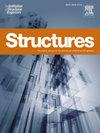Seismic performance of new detailing RCS connection with different axial compression ratio and FBP thickness
IF 3.9
2区 工程技术
Q1 ENGINEERING, CIVIL
引用次数: 0
Abstract
Reinforced Concrete column and Steel beam (RCS) structural system has been extensively studied due to the effective use of concrete and steel material and cost efficiency. Bearing failure and constructability were two main issues of RCS joint in practical engineering. To improve these two deficiencies, the authors proposed a whole-section diaphragm type RCS joint. This study aimed to examine the impact of axial compression ratio and face bearing plate (FBP) thickness on the seismic behavior of the proposed joint. In this research, six RCS joint specimens were designed to achieve joint failure and tested under cyclic loading. Shear failure was identified as the typical failure mode. The results revealed that higher axial, compression ratio could lead to higher cracking loads, with improved load-carrying capacity, stiffness, and energy dissipation capabilities. Additionally, the joint bearing distortion reduced as the axial compression ratio increased. All specimens displayed spindle-shaped hysteresis loops while the specimen without axial compression exhibited pinching effect. The presence of parallel FBPs significantly improved the shear capacity. However, as the thickness of the parallel FBPs increased from 6 mm to 10 mm, the load-carrying capacity showed limited enhancement. Moreover, a comparative analysis of current calculation methods was conducted. The results demonstrated that the AIJ and CECS347:2013 formulas showed acceptable accuracy in predicting the joint shear strength. These findings validated the applicability of the existing methods for proposed composite joints, while the effect of the axial compression ratio required further evaluation.不同轴向压缩比和 FBP 厚度的新型细化 RCS 连接的抗震性能
由于钢筋混凝土柱和钢梁(RCS)结构系统能有效利用混凝土和钢材料并具有成本效益,因此已被广泛研究。在实际工程中,承载失效和可施工性是 RCS 连接的两个主要问题。为了改善这两个不足,作者提出了一种全截面膜式 RCS 连接。本研究旨在考察轴向压缩比和端面支承板(FBP)厚度对拟议连接抗震行为的影响。在这项研究中,设计了六个 RCS 接头试件以实现接头失效,并在循环荷载下进行了测试。剪切破坏是典型的破坏模式。结果表明,较高的轴向压缩比可导致较高的开裂载荷,同时提高承载能力、刚度和能量消耗能力。此外,随着轴向压缩比的增加,关节轴承变形也会减小。所有试样都显示出纺锤形滞后环,而无轴向压缩的试样则显示出捏合效应。平行 FBP 的存在大大提高了剪切能力。然而,当平行 FBP 的厚度从 6 毫米增加到 10 毫米时,其承载能力的提高有限。此外,还对当前的计算方法进行了比较分析。结果表明,AIJ 和 CECS347:2013 公式在预测连接剪切强度方面表现出了可接受的准确性。这些结果验证了现有方法对拟议复合材料接头的适用性,而轴向压缩比的影响则需要进一步评估。
本文章由计算机程序翻译,如有差异,请以英文原文为准。
求助全文
约1分钟内获得全文
求助全文
来源期刊

Structures
Engineering-Architecture
CiteScore
5.70
自引率
17.10%
发文量
1187
期刊介绍:
Structures aims to publish internationally-leading research across the full breadth of structural engineering. Papers for Structures are particularly welcome in which high-quality research will benefit from wide readership of academics and practitioners such that not only high citation rates but also tangible industrial-related pathways to impact are achieved.
文献相关原料
| 公司名称 | 产品信息 | 采购帮参考价格 |
|---|
 求助内容:
求助内容: 应助结果提醒方式:
应助结果提醒方式:


